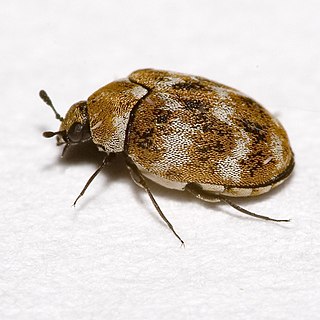
Anthrenus is a genus of beetles in the Dermestidae family, skin beetles. One of several genera of carpet beetles, Anthrenus was historically placed in a subfamily Anthreninae, though presently included in the Megatominae. The genus Neoanthrenus is closely related.
Utriculofera is a genus of moths in the subfamily Arctiinae erected by George Hampson in 1893.

Angomonas deanei is a flagellated trypanosomatid protozoan. As an obligate parasite, it infects the gastrointestinal tract of insects, and is in turn a host to symbiotic bacteria. The bacterial endosymbiont Ca. "Kinetoplastibacterium crithidii" maintains a permanent mutualistic relationship with the protozoan such that it is no longer able to reproduce and survive on its own. The symbiosis, subsequently also discovered in varying degrees in other protists such as Strigomonas culicis, Novymonas esmeraldas, Diplonema japonicumand Diplonema aggregatum are considered as good models for the understanding of the evolution of eukaryotes from prokaryotes, and on the origin of cell organelles.

Taeniotes is a genus of flat-faced longhorns beetles in the subfamily Lamiinae of the family Cerambycidae.

Hemilophus is a genus of longhorn beetles of the subfamily Lamiinae, containing the following species:
Hemilophus infuscatus is a species of beetle in the family Cerambycidae. It was described by Bates in 1881. It is known from Brazil.
Hemilophus unicolor is a species of beetle in the family Cerambycidae. It was described by Bates in 1881. It is known from Argentina, Paraguay, and Brazil.
Taeniotes leucogrammus is a species of beetle in the family Cerambycidae. It was described by James Thomson in 1865.

Stenaelurillus albopunctatus is a species of jumping spider in the genus Stenaelurillus that lives in Kenya. It was first described in 1949 by Ludovico di Caporiacco. The spider is medium-sized, with a cephalothorax between 2.24 and 23.55 mm long and abdomen between 2.38 and 3.92 mm long. It has two white stripes on its carapace and white speckles or spots on its abdomen. The female is generally lighter than the male. For example, the female has a brown and yellow carapace, which in the male is brown or black. The female clypeus and legs are yellow, while on the male they are brown. Otherwise, the colouration is similar to many other species in the genus. It is this similarity that led to the species Stenaelurillus guttiger being recognised as a member of the genus. The male has a spatula-like appendage at the front of its yellow pedipalps and a short thick embolus. The female has copulatory openings positioned very closely together and short insemination ducts.




